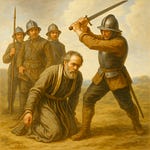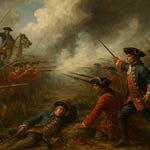For More Events on This Day in Irish History - https://thisdayirishhistory.com/may-13/
Welcome back to This Day in Irish History. I'm your host, Raymond Welsh. Before we dive into today's story, if you’d like to explore other significant events that happened on this day in Irish history, visit thisdayirishhistory.com—the link is in the episode description. Now, let’s take a lighter, more whimsical journey than usual, as we explore May 13th: celebrated by some as National Leprechaun Day, a playful nod to one of the most iconic figures in Irish folklore.
Though not an official holiday on the Irish calendar, National Leprechaun Day captures the imagination and enchantment at the heart of Ireland’s storytelling tradition. The leprechaun, that elusive, solitary fairy shoemaker, has tiptoed through Irish mythology for centuries—part trickster, part guardian of treasure, and always cloaked in mystery.
The roots of the leprechaun stretch deep into Celtic mythology. The name is thought to derive from the Old Irish luchorpán, meaning “small body,” a fitting description for this diminutive creature. Leprechauns were originally considered part of the Aos Sí—the supernatural race of beings that inhabited a parallel world, sometimes overlapping with our own. But unlike the nobler and often more fearsome members of the Aos Sí, the leprechaun was a figure of craft and cunning, more interested in solitude, shoemaking, and the occasional prank than ruling kingdoms or commanding magic.
One of the oldest references to the leprechaun can be found in a medieval tale called The Adventure of Fergus mac Léti, where the king of Ulster falls asleep by the shore and wakes to find himself being dragged into the sea by three luchorpáin. Fergus captures them and, in exchange for their release, they grant him three wishes—a motif that echoes in later tales and contributes to the leprechaun’s enduring mythos as a creature with access to magical wealth and hidden knowledge.
But perhaps what most people associate with leprechauns is their fabled pot of gold, buried at the end of a rainbow—a metaphorical destination that, like the creature himself, is always just out of reach. According to folklore, should you capture a leprechaun, he must grant you his treasure in exchange for his freedom. Yet leprechauns are masters of evasion and deceit, always outsmarting the greedy or the unwary with a clever trick, a riddle, or a sudden vanishing act.
It wasn’t until the 19th and 20th centuries that the leprechaun became the cheerful, green-coated figure we recognize today. Earlier depictions showed him in red, and far more malevolent in spirit. The transformation was driven largely by the romanticization of Irish folklore during the Celtic Revival and later amplified by mass media and global tourism. By the time St. Patrick’s Day emerged as a celebration of Irish identity in the diaspora, especially in the United States, the leprechaun had become its unofficial mascot: a grinning sprite in a shamrock hat, clutching a gold coin or puffing a pipe.
National Leprechaun Day, while invented in modern times—perhaps even as a marketing gimmick—offers an opportunity to reflect on how Irish myths have traveled and transformed. The leprechaun has become more than just a character in fairy tales; he’s a cultural ambassador of sorts, representing the wit, charm, and imagination for which Ireland is known. And though he’s been commercialized—found on cereal boxes, sports logos, and pub signs—his origins remain rooted in a much older, deeper world of myth.
At its heart, National Leprechaun Day is about honoring that legacy. It’s a chance to tell old stories, to pass on legends by firelight or classroom, to remember that Ireland’s history isn’t just political revolutions and bloody uprisings—it’s also mischievous fairies, sacred groves, and whispered bargains struck at twilight.
So whether you’re donning a green cap today, hunting for rainbows, or simply taking a moment to read a piece of Irish folklore, you’re participating in a tradition that spans generations—one that links the ancient with the modern, the magical with the mundane.
Thank you for joining me on this whimsical detour through Ireland’s folkloric past. Please like and subscribe, and until next time, I’m Raymond Welsh—Slán go fóill!










Share this post